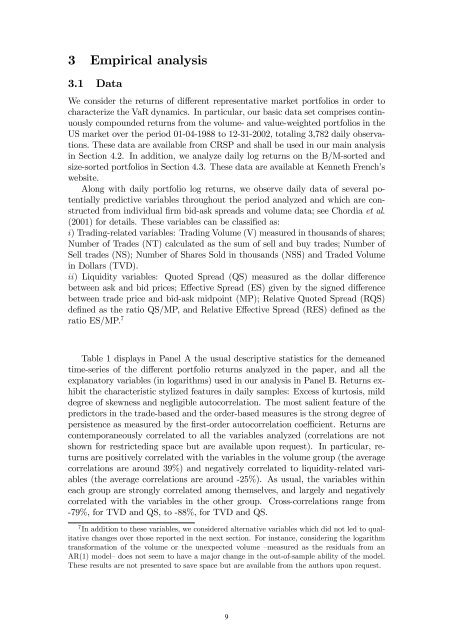Download PDF - Ivie
Create successful ePaper yourself
Turn your PDF publications into a flip-book with our unique Google optimized e-Paper software.
3 Empirical analysis<br />
3.1 Data<br />
We consider the returns of di¤erent representative market portfolios in order to<br />
characterize the VaR dynamics. In particular, our basic data set comprises continuously<br />
compounded returns from the volume- and value-weighted portfolios in the<br />
US market over the period 01-04-1988 to 12-31-2002, totaling 3,782 daily observations.<br />
These data are available from CRSP and shall be used in our main analysis<br />
in Section 4.2. In addition, we analyze daily log returns on the B/M-sorted and<br />
size-sorted portfolios in Section 4.3. These data are available at Kenneth French’s<br />
website.<br />
Along with daily portfolio log returns, we observe daily data of several potentially<br />
predictive variables throughout the period analyzed and which are constructed<br />
from individual …rm bid-ask spreads and volume data; see Chordia et al.<br />
(2001) for details. These variables can be classi…ed as:<br />
i) Trading-related variables: Trading Volume (V) measured in thousands of shares;<br />
Number of Trades (NT) calculated as the sum of sell and buy trades; Number of<br />
Sell trades (NS); Number of Shares Sold in thousands (NSS) and Traded Volume<br />
in Dollars (TVD).<br />
ii) Liquidity variables: Quoted Spread (QS) measured as the dollar di¤erence<br />
between ask and bid prices; E¤ective Spread (ES) given by the signed di¤erence<br />
between trade price and bid-ask midpoint (MP); Relative Quoted Spread (RQS)<br />
de…ned as the ratio QS/MP, and Relative E¤ective Spread (RES) de…ned as the<br />
ratio ES/MP. 7<br />
[Insert Table 1 around here]<br />
Table 1 displays in Panel A the usual descriptive statistics for the demeaned<br />
time-series of the di¤erent portfolio returns analyzed in the paper, and all the<br />
explanatory variables (in logarithms) used in our analysis in Panel B. Returns exhibit<br />
the characteristic stylized features in daily samples: Excess of kurtosis, mild<br />
degree of skewness and negligible autocorrelation. The most salient feature of the<br />
predictors in the trade-based and the order-based measures is the strong degree of<br />
persistence as measured by the …rst-order autocorrelation coe¢ cient. Returns are<br />
contemporaneously correlated to all the variables analyzed (correlations are not<br />
shown for restricteding space but are available upon request). In particular, returns<br />
are positively correlated with the variables in the volume group (the average<br />
correlations are around 39%) and negatively correlated to liquidity-related variables<br />
(the average correlations are around -25%). As usual, the variables within<br />
each group are strongly correlated among themselves, and largely and negatively<br />
correlated with the variables in the other group. Cross-correlations range from<br />
-79%, for TVD and QS, to -88%, for TVD and QS.<br />
7 In addition to these variables, we considered alternative variables which did not led to qualitative<br />
changes over those reported in the next section. For instance, considering the logarithm<br />
transformation of the volume or the unexpected volume –measured as the residuals from an<br />
AR(1) model–does not seem to have a major change in the out-of-sample ability of the model.<br />
These results are not presented to save space but are available from the authors upon request.<br />
7<br />
9

















